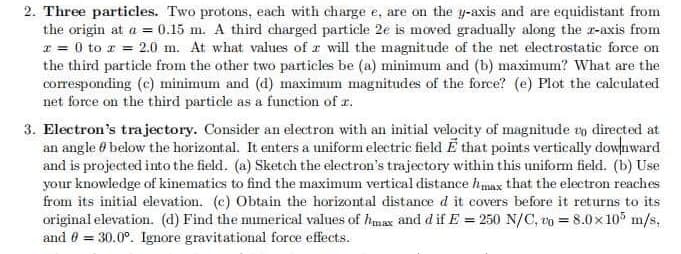2. Three particles. Two protons, each with charge e, are on the y-axis and are equidistant from the origin at a = 0.15 m. A third charged particle 2e is moved gradually along the z-axis from x = 0 to z = 2.0 m. At what values of a will the magnitude of the net electrostatic force on the third particle from the other two particles be (a) minimum and (b) maximum? What are the corresponding (c) minimum and (d) maximum magnitudes of the force? (e) Plot the calculated net force on the third particle as a function of . 3. Electron's trajectory. Consider an electron with an initial velocity of magnitude to directed at an angle below the horizontal. It enters a uniform electric field E that points vertically downward and is projected into the field. (a) Sketch the electron's trajectory within this uniform field. (b) Use your knowledge of kinematics to find the maximum vertical distance max that the electron reaches from its initial elevation. (c) Obtain the horizontal distance d it covers before it returns to its original elevation. (d) Find the numerical values of max and d if E = 250 N/C, 0 = 8.0×105 m/s, and @ 30.0°. Ignore gravitational force effects. =
2. Three particles. Two protons, each with charge e, are on the y-axis and are equidistant from the origin at a = 0.15 m. A third charged particle 2e is moved gradually along the z-axis from x = 0 to z = 2.0 m. At what values of a will the magnitude of the net electrostatic force on the third particle from the other two particles be (a) minimum and (b) maximum? What are the corresponding (c) minimum and (d) maximum magnitudes of the force? (e) Plot the calculated net force on the third particle as a function of . 3. Electron's trajectory. Consider an electron with an initial velocity of magnitude to directed at an angle below the horizontal. It enters a uniform electric field E that points vertically downward and is projected into the field. (a) Sketch the electron's trajectory within this uniform field. (b) Use your knowledge of kinematics to find the maximum vertical distance max that the electron reaches from its initial elevation. (c) Obtain the horizontal distance d it covers before it returns to its original elevation. (d) Find the numerical values of max and d if E = 250 N/C, 0 = 8.0×105 m/s, and @ 30.0°. Ignore gravitational force effects. =
Related questions
Question
Please answer asap!!

Transcribed Image Text:2. Three particles. Two protons, each with charge e, are on the y-axis and are equidistant from
the origin at a = 0.15 m. A third charged particle 2e is moved gradually along the z-axis from
x = 0 to z = 2.0 m. At what values of a will the magnitude of the net electrostatic force on
the third particle from the other two particles be (a) minimum and (b) maximum? What are the
corresponding (c) minimum and (d) maximum magnitudes of the force? (e) Plot the calculated
net force on the third particle as a function of z.
3. Electron's trajectory. Consider an electron with an initial velocity of magnitude to directed at
an angle below the horizontal. It enters a uniform electric field E that points vertically downward
and is projected into the field. (a) Sketch the electron's trajectory within this uniform field. (b) Use
your knowledge of kinematics to find the maximum vertical distance max that the electron reaches
from its initial elevation. (c) Obtain the horizontal distance d it covers before it returns to its
original elevation. (d) Find the numerical values of max and d if E = 250 N/C, to = 8.0x105 m/s,
and 0 = 30.0°. Ignore gravitational force effects.
Expert Solution
This question has been solved!
Explore an expertly crafted, step-by-step solution for a thorough understanding of key concepts.
Step by step
Solved in 2 steps
